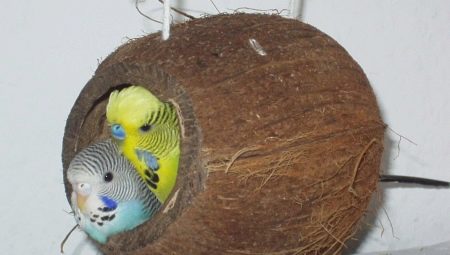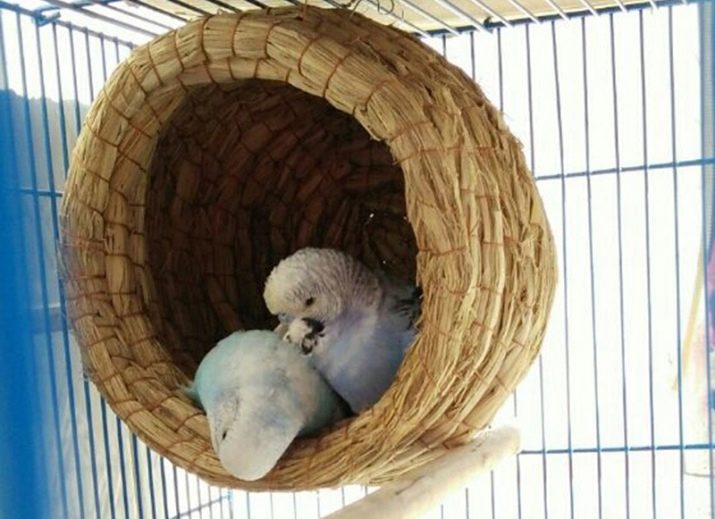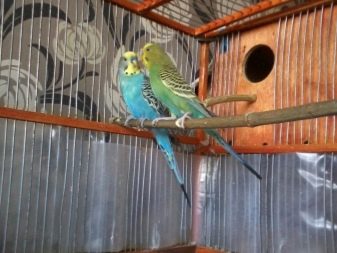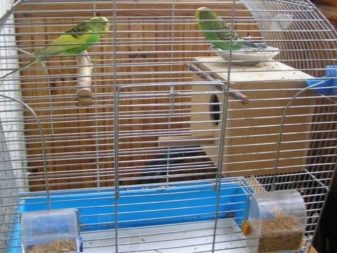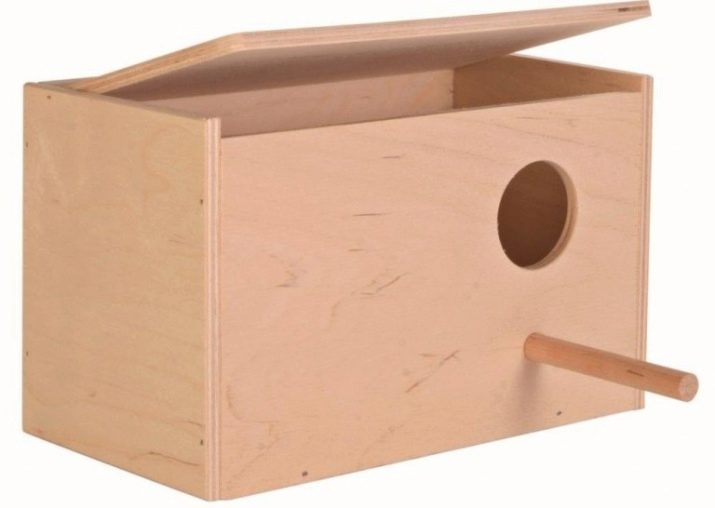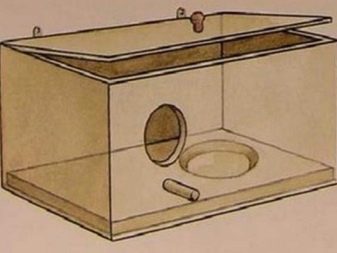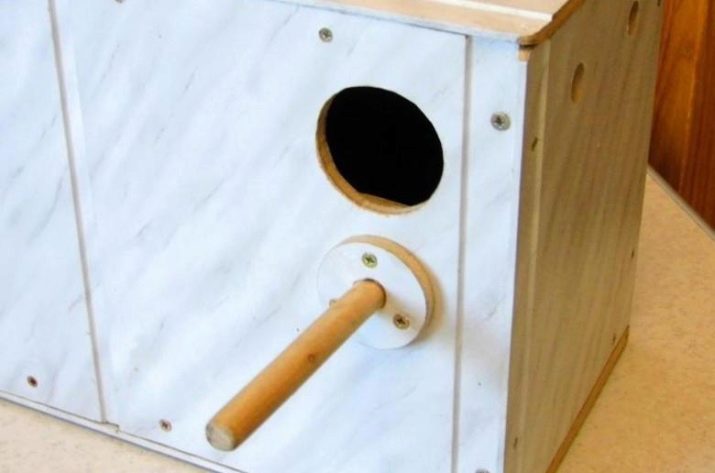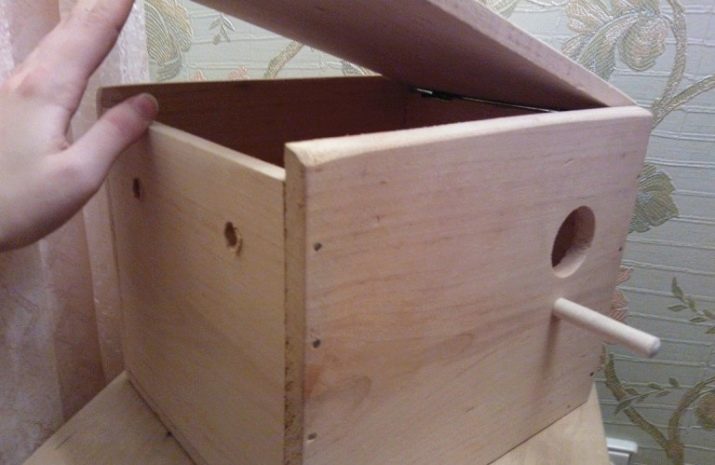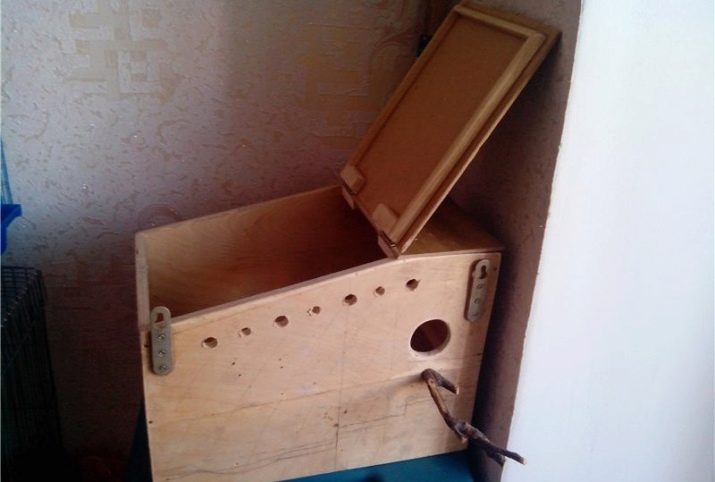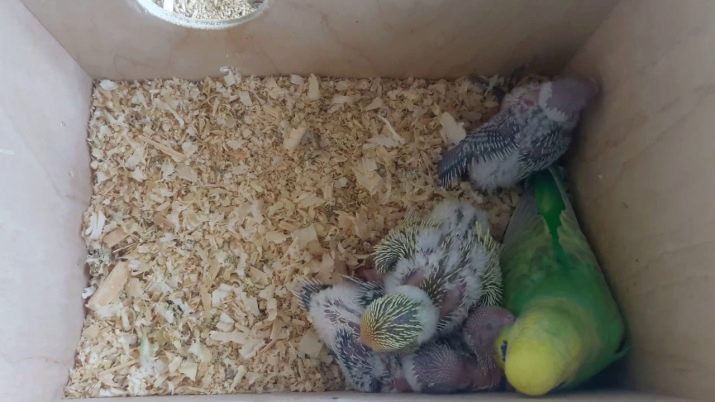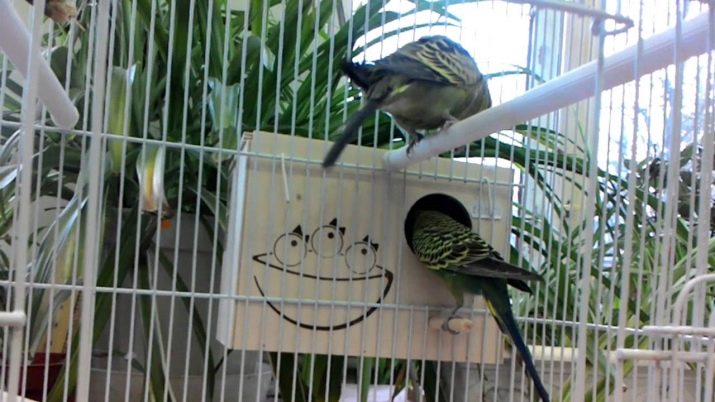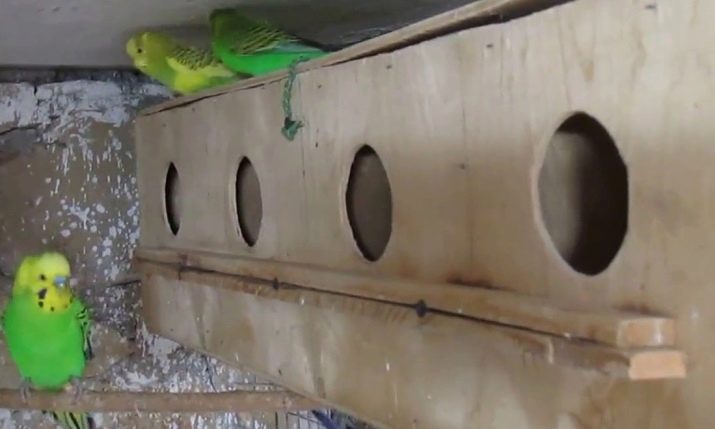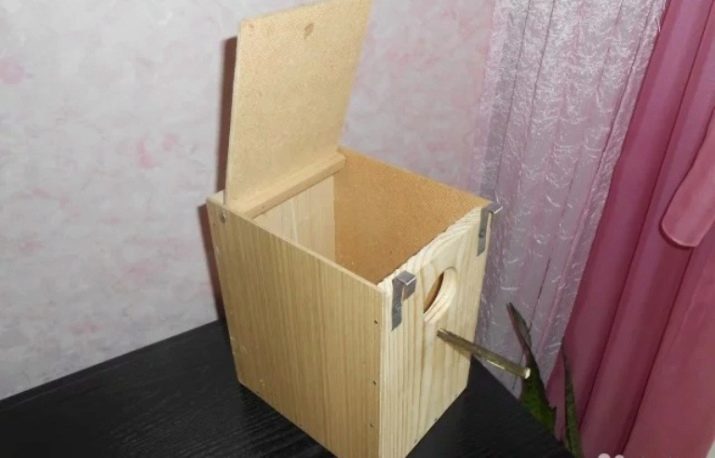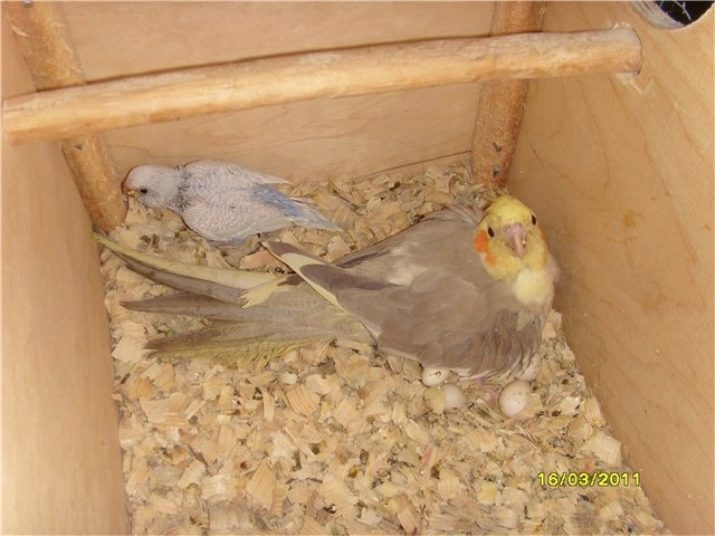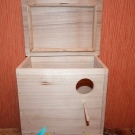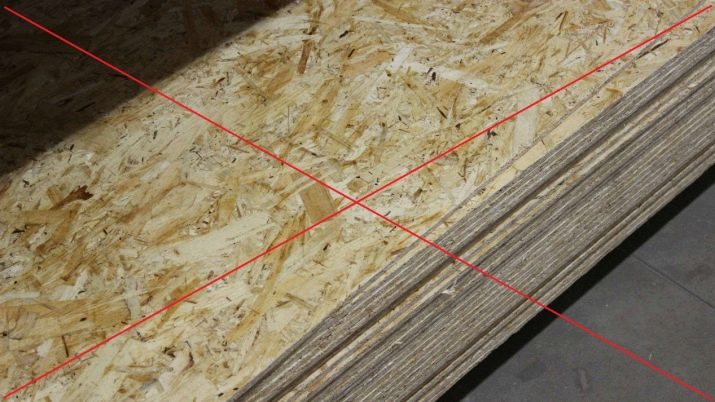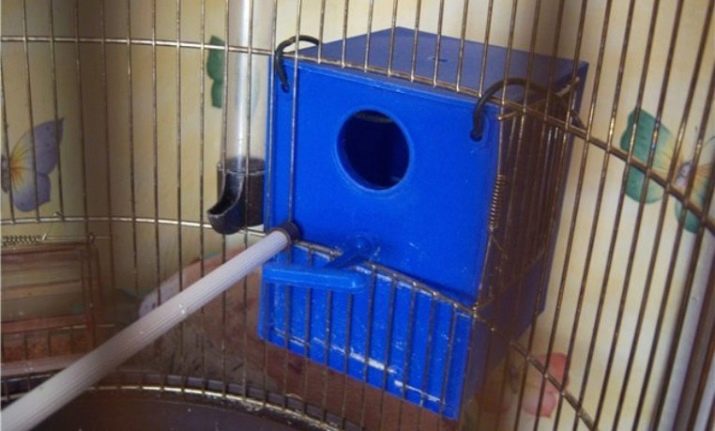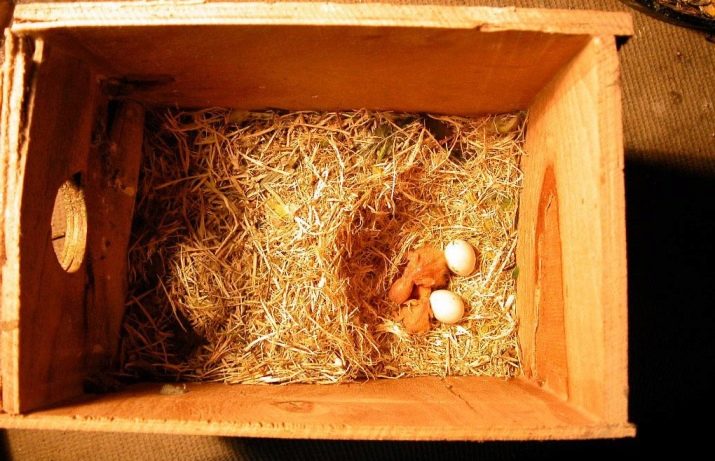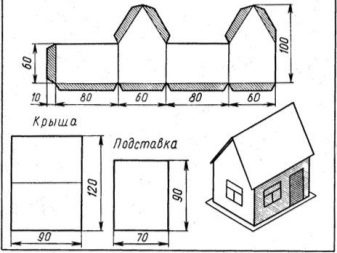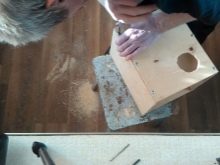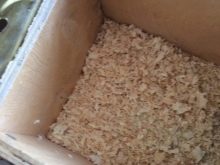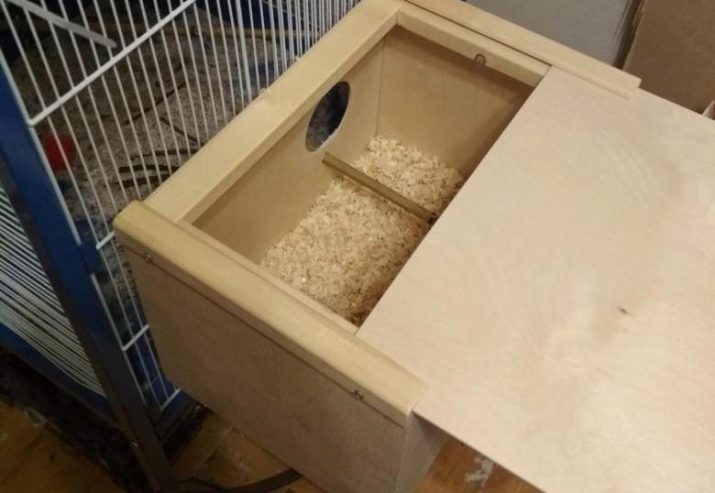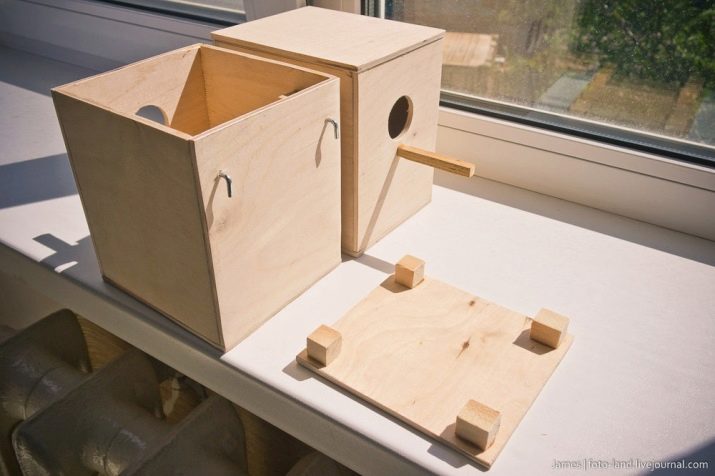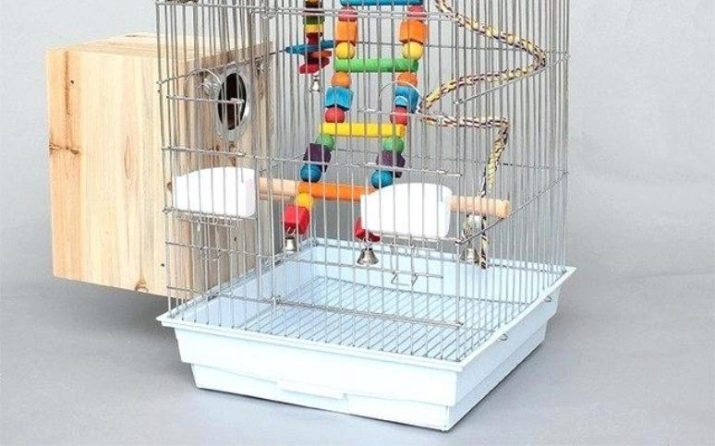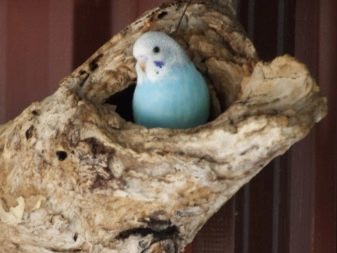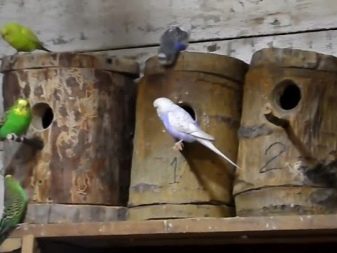Budgerigars are birds with a bright color and friendly disposition, so they are often chosen as pets. To make the parrots feel comfortable and mate productively, they need to be provided with a breeding house. This design can be purchased as a finished product, and make your own from scrap materials.
Features and requirements
In the wild, wavy parrots live in flocks and choose hollows in the trees as nests. They love a spacious and protected space, therefore, equipping their house, carefully clean the bottom of the nests from the dust.
As for keeping birds at home, storehouses or hand-made hollows are quite suitable for them.
The main thing is that they are comfortable and practical.
The house for breeding of wavy parrots is installed in a cage, in the construction of which two doors must be provided. In the first zone of the cage, the house itself is usually placed, and in the second, feeders and drinkers are installed. The main requirement for the nesting house include the availability of free space, which will further ensure the successful breeding and facilitate the process of care, not only for a couple of parrots, but also their chicks. In some cases, the nest is fixed from the outside of the cage, saving space for a small structure.
Experts still recommend placing a nesting house inside the structure, because it allows young parents to carefully examine it and feel more confident and calmer.
The nest for wavy parrots looks different and is made of various materials. Most often it is made of wood, giving preference to such species as birch, spruce and pine. The lid in it should be easy to open, because there periodically will have to pour sawdust and disinfect.
Details nesting house have a standard thickness. In the event that it is made independently from scrap materials, then the floor thickness should be at least 4 cm, walls and roofs should be 2 cm.
At the same time in the floor you need to make a small depression: this will allow the eggs to be in one place.
With such a thickness of the walls and the floor in the house a constant temperature will be created, there will always be heat, and the humidity will be maintained at the same level.
It is undesirable to acquire or make houses from chipboard, cardboard and plywood. They are very cold and will negatively affect the successful breeding of chicks. In addition, materials impregnated with glue and chemical composition will have a detrimental effect on the health of chicks and parrot parrots.
As well as the nesting structure should have mandatory elements.
Perch
She is placed downstairs near the entrance to the house so that the female can easily enter and exit. Otherwise, the bird will have to exert considerable effort when moving, and they will need it for reproduction and hatching. Therefore, the owners of wavy parrots should during the period of their marriage to maximally simplify the life of birds, which will increase the likelihood of obtaining healthy offspring.
Flip or removable cover
Due to this, access to the nest will be available from any point, which, in turn, will greatly facilitate the process of disinfection and cleaning the house.
In addition, when arranging a home hollow it is important to consider some nuances.
- Availability of fresh air. To do this, it is necessary that the design had several holes with a diameter of 0.8 to 1 cm. You can drill them yourself in the bottom of the house.
It is advisable to give preference to socket designs with a folding window.
- Convenience in cleaning. Before use and during the subsequent maintenance of birds, the house should be thoroughly washed, so its design should have free access to cleaning.
- Quality flooring. It is best to lay sawdust on the floor, as they absorb moisture well.
Litter paper is not suitable, as it will quickly get wet, which will create increased humidity in the nesting place.
- The size of the cell. These figures depend on the age, size and number of parrots, which are planned to contain. As a rule, budgerigars are placed one by one or in pairs. In order for a feathered pet to feel comfortable, at least 7% of the total space of the cage must fall on one individual.
Additional lighting is not necessary. For its normal level, there will be enough light that penetrates through the inlets.
What are the nests?
Today there are several types of nests for wavy parrots, each of which has its own characteristics.
Horizontal
It has the following dimensions: a width of 25x20 and a height of 15 cm. A notch in such a structure is located at a short distance from the top and side wall. The main advantage of the horizontal design is its convenient location. Due to the sufficient width of the notch, the female can freely enter and leave the house without damaging the clutch.
The minus of this model is the rather low placement of the year-old, which allows the chicks to get out of their shelter earlier than the allotted time.
The constructions of size 35x35x20 cm are also on sale; their entrance is located at a distance of 4 cm from the side wall and the upper edge. Additionally there is a window with a diameter of 5 cm, but in order to facilitate the penetration of birds into the nest, it is necessary to attach a small step under the entrance window.
Vertical
This type of nesting house is considered the most popular, since it is characterized by compact size, takes up little space and is convenient for parrots. In contrast to the horizontal model, the chicks in this design is fenced access to the exit. This is due to the fact that the notch is located high (at a distance of 3 cm from the upper edge). The dimensions of the vertical houses are 20x20 cm wide and 25 cm in height.
The lack of design is that females, returning to the nest, can damage the laying of eggs.
Compromise
This model is considered to be ideal, since it combines the best characteristics of vertical and horizontal houses. In addition, this type of construction is simple to assemble. Its dimensions are up to a height of 20 cm and a width of 25x20 cm. There is enough free space for the female to move comfortably through the nest. At the same time, chicks access to early departure is limited.
The main advantage of the compromise house is considered sufficient width of the nest. It allows birds to move freely in the structure and completely eliminates the possibility of damage to the clutch. Due to the large area in the house, proper conditions are created for keeping babies.
They are spacious, and weak parrots do not risk being crushed.
Selection of materials
Many owners of wavy parrots prefer to make their own nesting houses for them. The process of creating such a design is simple, but you need to know certain rules, how to arrange housing for the female and future chicks, and what material to choose for this. It is not recommended to use for the construction of chipboard houses, as the composition of this material includes adhesives and various resins, which can cause harm to newborns.
The ideal material for assembling a structure is wood.
To do this, choose the wall paneling or boards that have not been treated with paint, varnish and penoteksom. It is advisable to give preference to hardwood. Well suited for the construction of boards of beech, birch and linden with a thickness of up to 50 mm (from this material housing will get warm).
In that case, if the nesting house is planned to be purchased in finished form, then you can choose plastic products. They are inexpensive, but uncomfortable for birds.
Regardless of the material from which the house is made, the nest also needs to be equipped with bundles of dry grass, branches of bushes and trees. They are pre-doused with boiling water.
You should also make additional litter from sawdust.
How to do it yourself?
Before you start building a house with your own hands, you need to create its project and draw sketches, having previously decided on the choice of construction type and size. The drawings should include all the main parts of the house. After that, the preparation of a building material is carried out, which is ideal for boards from an array of raw materials that are not chemically treated. You can also buy for the assembly of the walls of the workpiece of a certain thickness, they are sold in each pet shop.
At home, experts recommend tinkering the roof, walls, and the floor for breeding birds. Thanks to this, the nest box will turn out warm, and constant humidity will be maintained in it.
Once the type of house is selected, you can start working.
- The first parts are preparing for the assembly of the roof, bottom and walls. To do this, first make sketches on paper, they are cut out and carefully transferred to the boards. Then carried out the cutting of parts with a hacksaw. At the same time, an additional hole should be cut out in the front wall, and 3-4 holes should be made in the side walls with a diameter of not more than 1 cm for ventilation.
- The next step will be the installation of parts with small screws, glue or nails. At the bottom of the entrance is to attach a small poroshek, and under the entrance to place the perch. It will also require the installation of a step inside to protect the eggs from falling out (so that the clutch is always in the same place, a recess 2 cm in diameter must be made in the bottom). The bottom of the house is filled with fine chips or sawdust.
Coniferous waste as a litter is not recommended: they contain resin, which, if it comes into contact with feathers, can glue an egg. Good for bedding dry chamomile.
- The assembly of the house ends with the installation of the roof. It is attached in such a way that it can be easily removed while cleaning the nest.
Before settling parrots in a made nesting box, all the details of its design must be disinfected, doused with boiling water. After that, the structure is washed again with cold water and dried well. In addition, it is important to check all the edges of the house: they should not protrude nails and have untreated surfaces.
After performing quality control, the nesting house is fixed inside or outside to one of the walls of the cage. It is possible to fix the structure with special hooks and brackets. The preparation of the nesting house will be completed by its arrangement, during which it must be remembered that adult budgerigars in such a structure will live only during nesting.
Therefore, it should not be supplemented with lamps, unnecessary items, mirrors and toys. They will be inappropriate.
Nest house can be made of plywood box, but it should not be painted with varnish or paint. A bird house is also a good breeding ground for budgies. Its design is much simpler in comparison with nested boxes from boards.
To make a tree house, you will need an electric drill, chisel, nails, wood chump or log with a rotten core.
Since the diameter of such housing should not be less than 22 cm, and the height - no more than 40 cm, markings are made in the middle of the log and a hole of the corresponding dimensions is made with chisel. Inside the hollow should be round and have a wall thickness of 2 cm. The roof in this case simply put on top or secured with a rope. It is advisable to install the resulting house outside the cage, having previously laid it with sawdust. After the hatchlings hatch and grow up, the nesting house is removed and hid for storage.
The technology of manufacturing nesting houses for parrots can be found in the following video.
